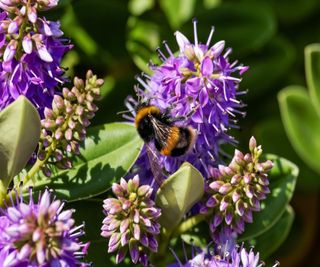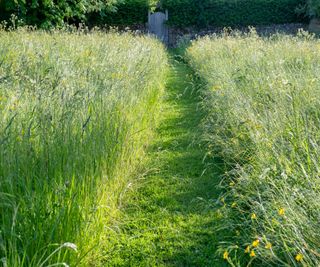Biodiversity is a word many of us are familiar with, but what exactly does it mean? Why is it important? And how can we foster biodiversity in our immediate surroundings? Simply put, it's about creating healthy ecosystems that provide beneficial effects, such as cleaning the air, maintaining healthy soil, and purifying and filtering water. Keeping these natural processes running smoothly supports many different life cycles and ultimately provides food and resources.
A changing climate and the resulting shifts in seasons are putting these natural processes under increasing disruption, making stewardship of your outdoor spaces even more important. Simple changes like growing more native plants and nectar-rich flowers for pollinators can attract more beneficial insects to your garden, strengthening the entire ecosystem. Similarly, adding habitat and hiding places for invertebrates and mammals can enhance natural pest control.
We spoke to leading industry experts and landscape designers to find out exactly what you can change in your garden – because knowing how to increase biodiversity is a lot easier than you think.
(Image courtesy of Getty/twomeows)
7 ways to increase biodiversity in your garden
It doesn't take much effort to increase the variety of wildlife you attract to your field and the frequency of their visits. Growing a variety of their favorite food sources – nectar-rich plants, fruit-bearing trees and berry-laden shrubs – and creating a variety of natural habitats like ponds, rock gardens and woodlands can go a long way.
Below, horticulture industry experts share seven simple ways we can all improve our local ecosystems.
1. Pamper your pollinators

(Image credit: Marcin Rogozinski / Alamy Stock Photo)
Butterflies, bees, moths and hummingbirds are just a few of the pollinators you should attract to your garden. Feeding on nectar and pollen, these insects carry pollen from plant to plant, fertilizing each one and essential for the production of future generations of plants and important food crops. Some plants attract these hardworking insects more than others because of the color, shape and scent of their flowers, so by incorporating these plants into your flower beds, pots and lawns, you can encourage this important process while enjoying a delightful sight.
“Study local insect and wildlife species and plant a variety of native plants that provide habitat, nectar sources and host plants,” advises Mary Phillips, native plant habitat and certification manager for the National Wildlife Federation. “Use the National Wildlife Federation's Native Plant Finder to find species that are suitable for your area. Be sure to include native plants that flower in different seasons to provide nectar for pollinators in the spring, summer and fall, as well as plants that provide seed heads and shelter for birds.”
Rather than sticking with a uniform lawn, Jonathan Ames, principal landscape designer at Bacqyard Landscape Design, recommends introducing different plant species to increase diversity: “Another option is to cultivate a wildflower patch. Designate a small area in your yard to be planted with vibrant wildflowers. They will attract pollinators like bees and butterflies, creating a mini-ecosystem.”
Learn how to plant a wildflower meadow and choose open, cup-shaped flowers like columbine, campanula, St. John's wort, and cornflower, which are especially accessible to insects. Try Nature Hills Wildflower Seed Mix, a blend of eight pollinator-friendly flowers.

Social Links Navigation
Native Plant Habitat and Certification Officer
Mary is an Ambassador for Native Plants and Director of Native Plant Habitat and Certification for the National Wildlife Federation. Her job is to ensure all habitat programs and resources are based on sustainable practices and the latest science.
2. Plant flowers in winter to extend the flowering season

(Image courtesy of Alamy/ Anna Watson)
Extending the flowering season in your garden also has a major impact on pollinators. Early-flowering trees and shrubs, such as witch hazel, daphne and viburnum, provide a valuable source of nectar for pollinators just emerging from winter hibernation.
Planting winter and early spring flowering bulbs is another important way to support pollinators and increase biodiversity in your garden.
“Snowdrops are beautiful planted alone in clusters or with yellow winter monkshood (Eranthus emalis), pink spring cyclamen (Cyclamen kuum), or early-flowering crocuses like tommies (C. tomacinianus),” says horticulture expert Peggy Ann Montgomery.
“The first flowers of spring are a precious signal of the beginning of the growing season and the return of light. They provide an important early source of pollen and nectar for pollinators, especially honeybees.”
3. Encourage wildlife, big and small

(Image courtesy of Alamy/ Tim Gainey)
Attracting wildlife into your garden is a great way to increase biodiversity. Supporting natural food chains and life cycles, these visitors can sometimes cause problems, but they also have a huge positive impact on plant and soil health, as well as providing endless fun.
Simple changes such as replacing fences or walls with hedges, introducing ground cover for hiding places and shelter, and growing climbing plants to provide cover for nesting birds and chicks can make a big difference.
By allowing the grass to grow long and native wildflowers to establish and grow, your lawn becomes an attractive spot for all kinds of wildlife, from beetles and snails to the birds and small mammals that feed on them, as well as animals at the top of the predation chain, such as birds of prey and foxes.
Another simple step is to not tidy up too much, as Mary Phillips suggests: “Consider leaving fallen logs, leaves and standing hollow trunks in your garden. These provide hiding places and overwintering sites for butterflies, moths, fireflies and beneficial beetles. Decomposers such as earthworms and pillbugs feed on the decomposing material, cycling nutrients through the soil.”
4. Consider planting trees to create wildlife habitat.

(Image courtesy of Alamy)
Planting trees in your garden will quickly attract lots of birds, insects and mammals – you'll have a complete mini-ecosystem that will instantly provide a habitat for a wide variety of creatures and also help control plant pests like aphids, wasps and caterpillars.
In addition to their visible beauty — intricately shaped and colored leaves, soft-to-the-touch bark, spring flowers, and fall fruits and seeds — trees also make hidden contributions to the health of your garden: Their extensive root networks help anchor and stabilize the soil, essential on sloping land or in land prone to frequent, heavy rainfall.
Besides anchoring the tree, roots have other important functions such as supplying the plant with water and nutrients, storing excess nutrients, transmitting chemicals that stimulate growth, leaf development and photosynthetic activity, and also nourishing and transforming the soil around the tree by producing certain chemicals, primarily for the tree's own needs.
Known as allelopathic plants, these plants can have both positive and negative effects on soil health, directly impacting the thriving of surrounding plants. For example, black walnut produces juglans, a toxic chemical that is particularly harmful to azaleas, pines and birches. Eucalyptus, pines and maples have similar tendencies, so it's important to take this into consideration when determining successful and healthy planting combinations.
5. Understand the value of water

(Image credit: Alamy/shoults)
Water, a key part of a biodiverse garden, is essential to support all life including plants, insects and wildlife. It is often incorporated into garden design for its stress-reducing properties and obvious sensory appeal, but it is important not to overlook its importance as a habitat, food source and everyday necessity.
“Birds, insects and other creatures need water,” explains Jonathan Ames, “and a basic bird bath or shallow water dish can have a big impact on their health.”
Large ponds, streams and meandering creeks all make stunning design features and provide the perfect conditions for growing a variety of specialist plants, thus attracting a wider range of garden visitors.
It's amazing how much diversity of life even the smallest body of water can host, from microorganisms to diving beetles, frogs, newts, damselflies, and dragonfly larvae. This shell-shaped butterfly pool from Amazon is easy to install on the tiniest deck or balcony and will have a big impact on local wildlife. Walmart also carries an incredible range of bird baths.

Social Links Navigation
Landscape Designer
With over 20 years of experience in the industry, Jonathan is a landscape designer at BACQYARD who combines a deep passion for plants with extensive experience across the country. His expertise ranges from growing ornamental plants to creating expansive landscapes.
6. Greening the grey areas

(Image courtesy of Alamy/ jjimages)
Adding plants to urban gardens, or gardens that consist primarily of hard landscaping, not only softens the space with greenery and flowers, making it more inviting, but it also creates beneficial habitat for wildlife.
Growing climbing plants up arches and pergolas, covering walls and fences with live green panels of leaves and vegetables, and creating sedum mats and wildflower meadows on rooftops will not only increase food sources for valuable pollinators and birds, but also provide hiding places and breeding sites.
The benefits of greening your garden and surroundings don't end there: replacing paved paths with hardy climbing plants and ground-loving plants can help regulate air temperature, filter out harmful dust and pollutants from the air, purify them and release them back out again. There's also evidence that adding more vegetation around your home can help manage your home's mini-climate, keeping temperatures down and reducing noise from neighbors.
7. Avoid chemicals

(Image courtesy of Alamy/ blickwinkel)
Changing your gardening and yard care habits to reduce the use of pesticides and other harmful substances can greatly increase the biodiversity in your garden. Replacing chemical pest control products with more natural pest control methods may temporarily alter the natural balance of your garden, but the effects will quickly even out and have less long-term negative effects on beneficial insect populations, food webs, and soil health.
There are a variety of options available, from simple household items such as coffee grounds, chilli powder, vinegar and lemon juice to the introduction of live pest control agents such as nematodes and ladybugs.
Growing certain plants known as trap plants, such as onions and chrysanthemums, can help deter pesky leaf-eating insects, and soil materials such as diatomaceous earth and lime act as effective barriers.
Another very effective solution is to attract natural predators to your garden. Birds, frogs and toads will feed on garden pests like cabbage blister beetles, aphids, slugs and snails. Add ground cover, suitable nesting sites, log piles, ponds etc to attract natural predators to problem areas like specific crops or flowers.
FAQ
Can pool chemicals have a negative impact on biodiversity?
Adding aesthetic chemicals such as black dye to streams and ponds, or using water purification products in pools and hot tubs, can have adverse effects on wildlife, large and small. Reduce wildlife exposure and cumulative effects by covering water surfaces when possible and quickly removing unwanted visitors.
Replacing a chemical pool with a natural swimming pond is a more environmentally friendly option, eliminating the need for chemical treatments and relying instead on a secondary filter pool made from a careful mix of purifying sand, gravel and plants.
Growing a garden and increasing biodiversity can be incredibly rewarding, not just for the satisfaction of watching the wildlife visit, but also the healthy impact it has on the soil, plants and immediate environment of your home. Overall, these small changes also have an impact on your neighbourhood and contribute to reducing the long-term effects of climate change.


